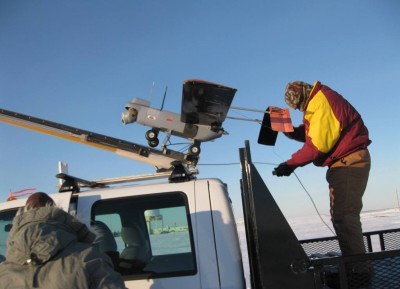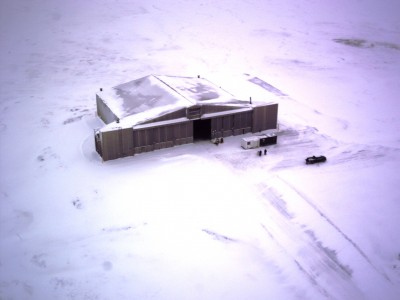
On October 22, a small flight team from New Mexico State University (NMSU) began the first in a series of test flights (see YouTube video) for the ARM Facility to evaluate various unmanned aerial systems (UAS) in the frigid Arctic conditions at Oliktok Point, Alaska. For eight days, the team conducted and documented short flights by a small unmanned aircraft, micro-helicopter, and tethered balloon.
“These systems hold the potential for autonomous research flights over the Arctic Ocean from ARM’s newest mobile facility stationed at Oliktok Point,” said Mark Ivey, site manager for ARM research facilities at the North Slope of Alaska.
The NMSU team was assisted by Ivey, Fred Helsel, and others from Sandia National Laboratories.
Mini-plane
The group started with a short flight by a “Bat-3” near the hangar area, followed by several slightly longer flights, including one out over the ocean for a brief time. This portable, medium-range, fixed-wing UAS can operate autonomously for up to 6 hours at a time, with an operational altitude of around 500 to 1500 feet above ground level. The aircraft can send and receive data up to 10 miles away to deliver high quality video imagery using color and infrared cameras.
Micro-helicopter
Next, the team tested an Aeryon Scout micro-UAV™ (Quadcopter) completing more than 10 test flights within the designated Restricted Area, R2204, located at Oliktok Point. The Scout’s stabilizers and downward-facing rotors give it the silhouette of a spider when on the ground. Weighing less than 3 pounds, it can be airborne in seconds after unpacking from a small case or backpack. A quadcopter is one option under consideration for deployment of radar retro-reflectors, essential for radar calibration.
Tethered Balloon
Finally, they tested a small “tether sonde”—basically a weather balloon tethered to the ground or a vehicle by a cable/winch system. This platform provides the capability to stay at a constant altitude for extended periods of time, as well as rapid and gradual ascents and descents through the air. During these “flights” instruments on the balloon can obtain vertical profiles—measurements from the sky below, in, and above the clouds. Tethersondes are one of the few safe options for measurement platforms flown inside icing clouds.

The Importance of Oliktok
Scientists need cloud and atmospheric data to better understand climate processes in the Arctic and to improve the computer models that simulate these processes to predict future climate. The Restricted Area at Oliktok Point, R2204, gives ARM the opportunity to gather these critical data.
In the future, ARM plans to equip UAS and tethered balloons with various sensors to obtain measurements of clouds, atmospheric conditions, sea ice, and heat exchange in this area. The Federal Aviation Administration is considering other airspace options that would allow additional atmospheric sampling operations to be conducted in the Oliktok area, possibly extending hundreds of miles over the Arctic Ocean.

